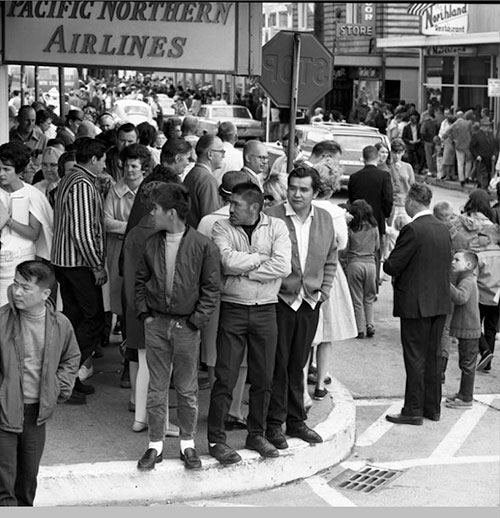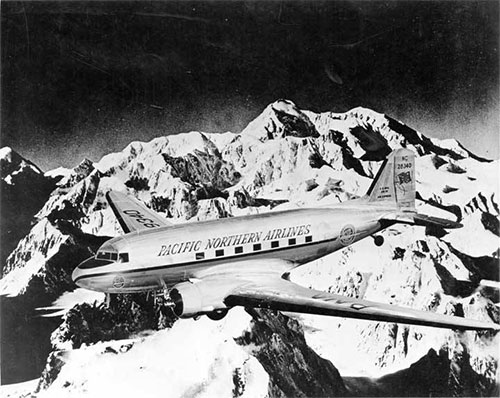
'The 'Alaska Flag Line' served Ketchikan for two decadesPacific Northern Airlines was a primary carrier for Southeast AlaskaBy DAVE KIFFER
September 13, 2017
Pan Am had been making flights to Alaska since the early 1930s and first serviced the Ketchikan area with Sikorsky Flying Boats in 1938 (See "Pan Am: Once Ketchikan's Link to the Outside World" SITNEWS, Dec. 29, 2006). Pacific Northern Airlines, which originally was founded as Woodley Airways in 1932, had been flying into Ketchikan since the early 1950s.
Founded by Arthur G. Woodley, the company claimed to have started the first "scheduled" Alaskan air service in 1932. It was also awarded the lucrative federal mail contract for much of south central Alaska and Bristol Bay in the early 1930s. Woodley was one of the pioneers of Alaskan aviation and a first class "character," at least according to aviation historian Robert Serling, who wrote many aviation history books including the official history of Alaska Airlines, called "Characters and Character." He wrote about Woodley as part of his 1978 history of Western Airlines, "The Only Way to Fly." "The President of Pacific Northern Airlines was Arthur G. Woodley - a man of iron will, unimpeachable integrity, awesome profanity, a streak of sentimentality the approximate depth of Carlsbad Caverns, the liquor capacity of a 747 wing tank and a hair trigger temper," Serling wrote in 1978. Woodley was known to fire employees and immediately hire them back. He refused to suffer fools and rarely brooked any dissention from the rank and file, although he was generally liked by his employees. He carried on decades-long feuds with the leaders of other airlines and firmly believed that anyone who "wasn't with us, was against us," Serling wrote. "His personal idiosyncrasies had to be forgiven if not forgotten in light of what he accomplished for an airline that literally grew up with the area it served so well," Serling wrote. "PNA was the first Alaska carrier to develop its own communications system, the first to operate multi-engine aircraft, the first to utilize instrument flight procedures." Like many early Alaskan entrepreneurs, Woodley extend credit to drum up business, according to his March 31, 1990 obituary in the New York Times. "He extended credit to his passengers until the end of each trapping season.," the Times reported. "In 1935 he estimated that he was owed $300,000, but all of it was eventually paid." Woodley was a New Englander and learned to fly after World War I. He first came to Alaska in 1928 to visit his brother, a priest in Anchorage. In 1931, Woodley's brother died in a hunting accident and Woodley came back to the funeral. "After the funeral, Woodley just stayed in Anchorage," Serling wrote. "He had flown a five-passenger Bellanca there all the way from New York, landing with one cup of gas in the tank, and this was the plane he used to launch Woodley Airways out of Anchorage (a place) with only 2,500 hundred inhabitants. Woodley Airways fitted nicely with the minuteness of its base. It consisted of President Woodley, pilot Woodley, mechanic Woodley and salesman Woodley, a one man airline with one airplane." Woodley began as a charter service, flying passengers and freight anywhere in the state. He made some of the first flights to places such as Nome for fees up to $150, which were significantly cheaper - and quicker - than the $750, month-long sled dog trips. The Bellanca could make it from Anchorage to Nome in 5 1/2 hours, according to Serling.
In 1934, the post office granted Woodley the lucrative mail routes which allowed the airline to operate with a steady income and in 1942, the recently created Civil Aeronautics Board (CAB) awarded Woodley a Certificate of Public Convenience and Necessity to operate between Anchorage, Bristol Bay, Seward, Kenai and other parts of the central and southwest Alaska, essentially creating a near monopoly for the company. In 1944, Woodley was granted a route to Kodiak and then it was named the "prime connector" between Anchorage and Juneau and also awarded routes to Cordova and Yakutat. In 1947, the company officially changed its name to Pacific Northern Airlines. Up until the late 1970s, the airline industry was tightly regulated by the United State government with the intention of preserving service to lesser served areas by limiting competition and creating monopolies. Beginning during World War II, the CAB determined which airlines could operate in which parts of Alaska. Initially Pan Am was given much of the lucrative routes from Seattle into Alaska while other airlines, such as Alaska Airlines and Pacific Northern, operated routes within the state. When air travel began to boom in the 1950s, both Alaska and Pacific Northern were given routes that connected with Seattle and other locations outside Alaska. "By 1959, PNA's route system was strong compared with that of Alaska Airlines," David Stringer wrote in the August 2017 issue of Airways magazine, the bible of the commercial flight industry. "...Woodley had decided early on that a network of bush routes blended badly with 'mainline flying.' In 1953, with the blessing of the (CAB) he farmed out a number of the small village services to Bristol Bay Airlines and concentrated on PNA's more popular routes around the southern corner of the state." Stringer writes that the company's biggest break came in 1951. "PNA was awarded routes to the Outside, nonstop between Anchorage and Seattle and between Juneau and Seattle, with permission to continue on to Portland, Oregon. The Anchorage route would be in direct competition with Northwest Airlines (then called Northwest Orient) and the Juneau link would compete head--to-head with Pan American." At the same time Alaska Airlines was given permission to expand "Outside" and was given a direct flight from Fairbanks to Seattle. "Woodley saw this as too many certified carriers vying for the traffic between the Lower 48 and Alaska," Stringer wrote. "And he also did not care much for Alaska Airlines and its management." Part of that animosity stemmed from a previous attempt by Woodley to establish an earlier airline named Alaska Airlines. That effort was denied by the CAB and another airline, Star Air Lines, eventually co-opted the name Alaska Airlines, according to Stringer. "One story, told in the 49th State aviation circles has it that after that defeat (the effort to create the new airline) Woodley attempted to change the name of Woodley Airways to Alaska Airlines," Stringer wrote. "The paperwork was filed and sent off to Juneau but, supposedly, Woodley's attorney had neglected to enclose the US$15 application fee in the envelope. Woodley's request was invalidated and Star got the right to use the title Alaska Airlines. Woodley settled for the name Pacific Northern, and Alaska Arilines remained his nemesis until the time of PNA's demise." One small measure of revenge occurred when PNA branded itself "The Alaska Flag Line" and painted the Alaska flag on all its planes. In 1959, it rebranded itself again as the "Flag Line of the 49th State." The year Alaska became a state was also the high point of PNA's fight with Alaska Airlines. PNA turned profits in 1958 and 1959, while Alaska Airlines lost money. The passenger numbers were even more telling with Alaska having 49,000 passengers to PNA's 120,000 according to Stringer. But a major shift in the industry would also shift the balance of power away from PNA. Turbojets entered the market. Both Pan Am and Northwest introduced jets on their routes in 1960 and Alaska followed suit in 1961. Meanwhile, PNA continued to rely on its workhorse, the Lockheed Constellation or Connie, one of the most distinctive planes ever built. But while the propeller driven Connies had allowed PNA to lead the industry in the 1950s, they could not keep up with the new Boeing and Convair jets that were more luxurious and faster between Alaska and the Lower 48 in the 1960s. In 1962, PNA finally purchased a pair of Boeing 720s. By the mid 1960s, PNA was losing its competitive edge to the other carriers, but it was the Federal Government which hastened the airline's demise. "Over the years, the CAB had suggested that Alaska Airlines and PNA merge to reduce the subsidy paid to the carriers," Stringer wrote. "This was not going to happen. Behind closed doors, Pan American and Pacific Northern held discussions off and on (for several years)...there was no agreement on that combination either." PNA had also been stymied by the CAB in numerous attempts to expand its coverage further into the Pacific Northwest and elsewhere, including Hawaii. Woodley's battles with federal regulators were legendary in Alaskan aviation circles and he butted heads with regulators incessantly, nearly always coming up with the short end of the stick, according to Serling. Then in 1965, the CAB revoved Pan Am's right to fly into Alaska, contending that the market could not support four separate carriers. PNA's stake in the Alaska market became more valuable and that attracted the attention of Western Airlines. On July 1, 1967, the CAB approved the merger of Western and PNA. PNA ceased to exist and Art Woodley joined Western's board of directors. "There was surprisingly little industry opposition to the merger even though it was in apparent conflict with the CAB's record of rejecting mergers between healthy carriers," Serling wrote. "Both Western and PNA had just come off the most profitable year in their respective histories, but the CAB announced its approval anyway...one of the few times the Board had given Arthur G. Woodley what he wanted." Of course, Western was eventually absorbed by Delta Airlines, meaning that at least a touch of Woodley's airline DNA still flies the Alaskan skies.
Related:
On the Web:
Contact Dave at dave@sitnews.us Dave Kiffer ©2017 Representations of fact and opinions in comments posted are solely those of the individual posters and do not represent the opinions of Sitnews.
|
||||

